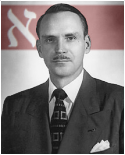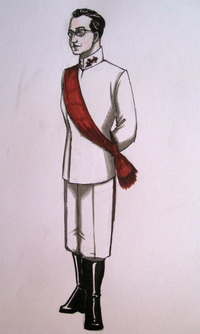Nohsi of Ashkenatza
| Nohsi of the Republic of Ashkenatza נשיא דאר רעפובליק פון אשקענאצא | ||

| ||
| Arms of Ruzhin Palace, Kolmenitzkiy | ||

| ||
| Incumbent | ||
| 14th Nohsi Leon Gambetta | ||
| since 28th May 2012 | ||
| Style | Your Excellency | |
| Residence | Ruzhin Palace | |
| Appointer | Ashkenatzi Knesset | |
| Term | 90 days | |
| Inaugural holder | 1st Nohsi Laz Krakowski | |
| Formation | 2008 | |
The Nohsi (נשיא) of Ashkenatza (pronounced noʊsiː) is the nation's executive head of state, residing in Ruzhin Palace, Kolmenitzkiy as defined by the Ben Mavet Constitution of 2009. The position commands significant power in the Republic due to the scope of the Nohsi's Executive Orders (Nohsibafeln) which has caused some controversy in Ashkenatzi politics. The Nohsi's duties in the Constitution are outlined as being 'upholding the Constitution', 'implementing the will of the Knesset', and 'defending the nation's kehile (Community), land (Territory) and kultur (Culture). The Nohsi is able to appoint ministers and executive agents through his or her executive orders but can be held to task for misuse of the significant power vested in the position.
The title of 'Nohsi' derives from the Biblical Hebrew word for Prince and modern Hebrew word for President, which is rendered into Latin Yiddish orthography as 'Nohsi'. In many ways the Nohsi is a cultural figurehead of the state as well, and is expected to make official statements on developments at home or abroad.
Though the title of 'Nohsi' may be misleading given that Ashkenatza is a Presidential Republic, the title was devised deliberately to add a sense of uniqueness to the office of Head of State of Ashkenatza. Nohsi terms last for ninety days but may last longer if the Nohsi rules under a provisional administration or if the Knesset and its Speaker vote to extend the Nohsi's rule or to postpone elections. The inauguration ceremony for the Nohsi is traditionally very elaborate and has since the Third Nohsi been conducted to much the same ceremony (with a few additions), in which the Nohsi takes soil from Ashkenatza and casts it to the four winds (To the North; to Izaria and Zaprogia, to the Tsofnland and Nordpunkt, To the South; to Porolia, To the East; to the Litovinas, both White and Regular, and the Tellias, hither and thither, to the Mahoz, to the Mala'Eretz, To the West; to the Kossars; to Porolia, Volhyria and Kolmenitzkiy) before donning a Tallit should the Nohsi be of Jewish faith to show the strength of their oath to lead the nation to the best of their abilities. The Nohsi then recites a highly elaborate oath that celebrates the democratic values of the Republic and continues to emphasise the commitment of the incumbent Nohsi to the values of the constitution.
As the Head of State the Nohsi is also a figurehead of the entire Republic and as such his or her background is equally important in how Ashkenatza is portrayed. One of the most important events in this regard was the election of ethnically Tellian Nohsi Bartholomeo Henzelli in August 2010, breaking the trend until then of Jewish Nohsim. There has not yet to date been a Nohsetzin (female Nohsi). Since the shift in Ashkenatzi political culture due to Maroonism, the Nohsi has taken on an added mystique which seems him/her as the physical manifestation of democratic values and rights of the voter-citizens of the Republic - the Nohsi therefore has accumulated numerous honorific titles - very much in use - such as Avatar of the Republic, The one from many, Eternal Tribune, Wraith of the people and The lightning from the ballots.
Many of Ashkenatza's leading citizens have at some point been Nohsi of the Republic throughout their micronational career including a former Shahanshah of Babkha, Pachad Emet ben Mavet, a Prime Minister of Victoria, Guy Zalmanov, and three times Moshe Goltz. Several Nohsi administrations have been conducted as provisional and emergency rules, and some under coalition governments. To date the Ashkenatzer Algemeyner Bund has provided the most Nohsim (Six).
Note that neither Laz Krakowski's leadership from August to September 2008 was as head of a Provisional Government before the title of Nohsi had been decided for that of Executive Head of State. Hence during this period Krakowski ruled as 'Acting President', and began his term as First Nohsi only after September of that year.
List of Nohsim
| Picture | Name | Period | Party |
|---|---|---|---|

|
Laz Krakowski | August 2008 - September 2008 (as Acting President of the Republic) | Provisional Administration |

|
Laz Krakowski | September 2008 - January 2009 | Dray Bagrif - Bund Coalition |

|
Moshe Goltz | January 2009 - April 2009 | Algemeyner Bund |

|
Pachad Emet ben Mavet | 9 April 2009[1] - 10 May 2009[2] | Yashkenatza Beiteinu |

|
Moshe Goltz | 18 May 2009[3] - 30 May 2009[4] | Algemeyner Bund |

|
Szhmuel Astopov | 11 June 2009[5] - 12 August 2009[6] | Ashkenatzi Democratic Party - GTL Coalition |

|
Moshe Goltz | 12 August 2009[7] - 9 November 2009[8] 10 November 2009[9] - 14 February 2010[10] |
Algemeyner Bund |

|
Chaim Wajnstein | 14 February 2010[11] - 5 April 2010[12] | Algemeyner Bund |

|
Pachad Emet ben Mavet | 15 April 2010[13] - 9 July 2010[14] | Natsyonal Farband |

|
Bartolomeo Henzelli | 2 August 2010[15] - 30 December 2010[16] | Algemeyner Bund |

|
Guy Zalmanov | 30 December 2010[17] - 6 May 2011[18] (term extended by the Nohsi (Renewal and Elections) Act 2011) | Independent |

|
Bartolomeo Henzelli | 6 May 2011[19] - 5th August 2011 | Algemeyner Bund |

|
Musa Mohammed Al-Harizi | 5th August 2011[20] - 8th August 2011[21] | Tsenterpartey |

|
Szhmuel Astopov | 17th August 2011[22]- 28th May 2012 | Ashkenatzi Democratic Party |

|
Leon Gambetta | 28th May 2012[23]- Incumbent | Independent |
References
- ^ http://dr-spangle.com/Mikrah/phpBB3/viewtopic.php?p=1761#p1761
- ^ http://dr-spangle.com/Mikrah/phpBB3/viewtopic.php?f=65&t=430
- ^ http://dr-spangle.com/Mikrah/phpBB3/viewtopic.php?f=65&t=432
- ^ http://dr-spangle.com/Mikrah/phpBB3/viewtopic.php?f=65&t=447
- ^ http://dr-spangle.com/Mikrah/phpBB3/viewtopic.php?f=65&t=507
- ^ http://dr-spangle.com/Mikrah/phpBB3/viewtopic.php?f=64&t=602
- ^ http://dr-spangle.com/Mikrah/phpBB3/viewtopic.php?f=64&t=602
- ^ http://dr-spangle.com/Mikrah/phpBB3/viewtopic.php?f=64&t=739
- ^ http://dr-spangle.com/Mikrah/phpBB3/viewtopic.php?f=49&t=778
- ^ http://dr-spangle.com/Mikrah/phpBB3/viewtopic.php?f=65&t=1024
- ^ http://dr-spangle.com/Mikrah/phpBB3/viewtopic.php?f=65&t=1024
- ^ http://dr-spangle.com/Mikrah/phpBB3/viewtopic.php?f=49&t=1144
- ^ http://dr-spangle.com/Mikrah/phpBB3/viewtopic.php?f=65&t=1177
- ^ http://dr-spangle.com/Mikrah/phpBB3/viewtopic.php?f=49&t=1492
- ^ http://dr-spangle.com/Mikrah/phpBB3/viewtopic.php?f=64&t=1530
- ^ http://dr-spangle.com/Mikrah/phpBB3/viewtopic.php?f=21&t=1925
- ^ http://dr-spangle.com/Mikrah/phpBB3/viewtopic.php?f=33&t=1926
- ^ http://ashkenatza.net/phpBB3/viewtopic.php?p=15018#p15018
- ^ http://ashkenatza.net/phpBB3/viewtopic.php?p=15018#p15018
- ^ http://ashkenatza.net/phpBB3/viewtopic.php?f=33&t=2635
- ^ http://ashkenatza.net/phpBB3/viewtopic.php?f=65&t=2649
- ^ http://ashkenatza.net/phpBB3/viewtopic.php?f=33&t=2666
- ^ http://ashkenatza.net/phpBB3/viewtopic.php?f=33&t=3073
